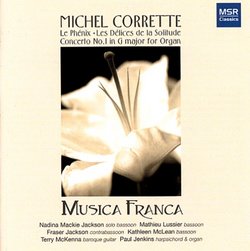Product DescriptionThe amalgam of seemingly separate elements is a theme for this group. Our name is inspired by the synthesis of French and Italian styles through the music of our two composers, those great friends of the bassoon, Michel Corrette and Joseph Bodin de Boismortier. As the the cultural hub of Europe, Paris seethed with artistic activity and the inevitable clash of ideas. Artistic and political perspectives were entwined resulting in fierce exchanges of polemical pamphlets, the medium for invective of the day. And yet, Corrette and Boismortier wrote music that is more genial than confrontational, devoid of defiance yet possessing a certain buoyant confidence. While they share certain qualities, Corrette and Boismortier are also distinctly different composers. Corrette's six sonatas of Les Délices de la Solitude and Le Phénix are written higher in the range of the bassoon and the overall spirit is openly playful and inventive. Many of the movements reveal an all-or-nothing passion that is never melancholy or rancorous. Even the titles of the works are poetically suggestive rather than explanatory. The Boismortier sonatas show an infinite variety of colour and gesture, a larger world hinted at through the medium of miniatures. Incisive subtlety and feline grace define these pieces while demanding the utmost virtuosity. In perusing the five volumes of sonatas by Boismortier for two bass voices, we have chosen pieces that interested us the most. These offer a perspective on the evolution of Boismortier's writing and style throughout his entire career. We present the complete works for bassoon by Corrette in Volume II of Musica Franca, and add a organ concerto in homage of his reputation as a virtuoso on this instrument. Using the facsimile editions of the original printings has allowed us to come as close as possible to realizing the original intentions of the composer. At the same time, we have also sometimes taken the liberty of varying the instrumentation, sometimes even within the same sonata, in the search for the widest range of tonal colours. In the works of both these composers, the mere notes on the page have a deceptive simplicity. This music immediately reveals the spirit of the performer, giving full value to the concept of "interpreter." While all of us are, including our engineer and producer, experienced performers on historical instruments, we have chosen to make this recording on modern instruments. Rather like the musicians of the eighteenth century, it was in the spirit of pleasure in music-making that this recording project was conceived.


 Track Listings (26) - Disc #1
Track Listings (26) - Disc #1